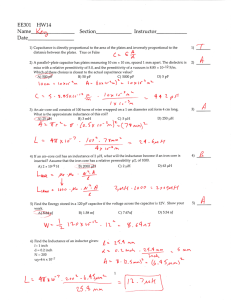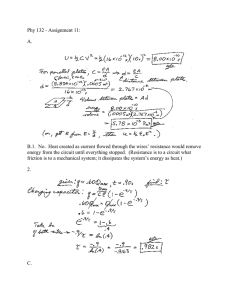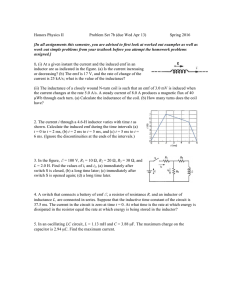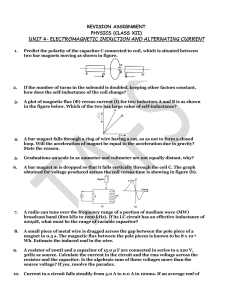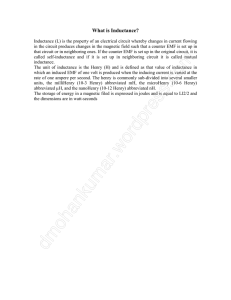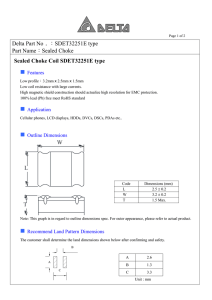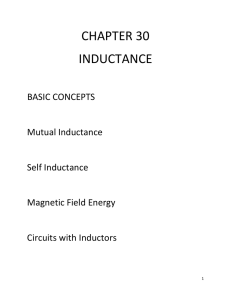lecture 15
advertisement
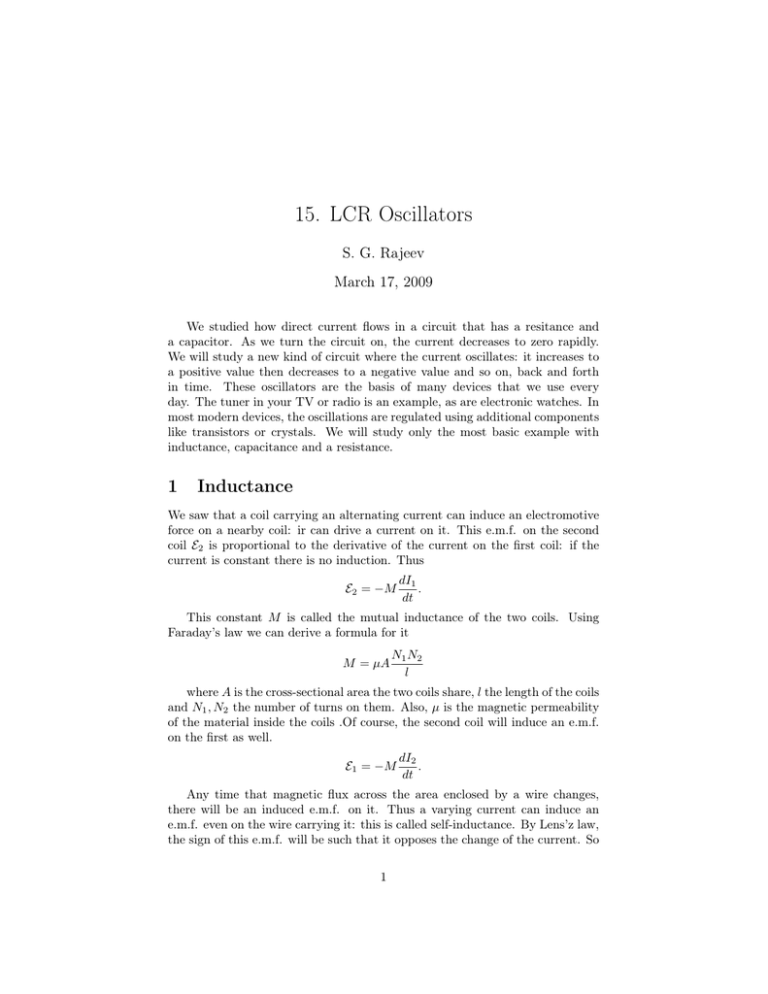
15. LCR Oscillators S. G. Rajeev March 17, 2009 We studied how direct current flows in a circuit that has a resitance and a capacitor. As we turn the circuit on, the current decreases to zero rapidly. We will study a new kind of circuit where the current oscillates: it increases to a positive value then decreases to a negative value and so on, back and forth in time. These oscillators are the basis of many devices that we use every day. The tuner in your TV or radio is an example, as are electronic watches. In most modern devices, the oscillations are regulated using additional components like transistors or crystals. We will study only the most basic example with inductance, capacitance and a resistance. 1 Inductance We saw that a coil carrying an alternating current can induce an electromotive force on a nearby coil: ir can drive a current on it. This e.m.f. on the second coil E2 is proportional to the derivative of the current on the first coil: if the current is constant there is no induction. Thus E2 = −M dI1 . dt This constant M is called the mutual inductance of the two coils. Using Faraday’s law we can derive a formula for it M = µA N1 N2 l where A is the cross-sectional area the two coils share, l the length of the coils and N1 , N2 the number of turns on them. Also, µ is the magnetic permeability of the material inside the coils .Of course, the second coil will induce an e.m.f. on the first as well. E1 = −M dI2 . dt Any time that magnetic flux across the area enclosed by a wire changes, there will be an induced e.m.f. on it. Thus a varying current can induce an e.m.f. even on the wire carrying it: this is called self-inductance. By Lens’z law, the sign of this e.m.f. will be such that it opposes the change of the current. So 1 E = −L dI . dt The constant L, called self-inductance (shortened to inductance) has a formula as well, derived from Faraday’s law L = µA N2 . l Again N is the number of turns in the coil, l its length and A the area. To have a large inductance, the coil can be filled with a material with a large magnetic permeability ( like iron). The unit of inductance is Henry. Clearly a Henry is the same as Volts.(1/Amperes).secs. 1.1 An Example A 3.81 m-long coil containing 225 loops is wound on an iron core (average µ = 1850µ0 ) along with a second coil of 115 loops. The loops of each coil have a radius of 1.00 cm. The mutual inductance is M = µA 225 × 115 N1 N2 = 1850 × 4π × 10−7 π(0.01)2 = 4.96 × 10−3 H l 3.81 The self inductance of the first coil is L1 = µA N12 2252 = 1850 × 4π × 10−7 π(0.01)2 = 9.7 × 10−3 H l 3.81 while that of the second coil is L2 == µA 2 N22 1152 = 1850 × 4π × 10−7 π(0.01)2 = 2.53 × 10−3 H. l 3.81 An LC Circuit Inductance represents the inertia of an electric current. The more the inductance, the more it will oppose changes in the current. An inductor is happiest (has no induced e.m.f.) when it has a constant current flowing through it. A Capacitor on the other hand, is in a hurry to get rid of the electric charge stored in it: it is happiest (has zero e.m.f.) when it carries no charge. By putting an inductance and a capacitance together we can trick them into oscillating back and forth between their states of maximum and minimum e.m.f. In any real circuit, the wires carrying the current will have some resitance. But as a first step we ignore this and consider an ideal circuit with only L and C. Also, as a first step we assume there is no external e.m.f. applied: no battery or AC power source. The e.m.f. of the inductance and the capacitance must add up to zero 2 −L dI Q + = 0. dt C But recall that current is the rate of discharge of the charge on the capacitor Q: I=− dQ . dt Combining these we get dI 1 = Q dt LC dQ = −I. dt This pair of differential equations can be solved in terms of familiar functions. What is a pair of functions so that the derivative of one is a constant times the other? Recall that d sin θ = cos θ dθ d cos θ = − sin θ dθ So for a constant ω, d sin ωt = ω cos ωt dt d cos ωt = −ω sin ωt dt This looks a little more like what we want. If we put Q(t) = Q0 cos ωt for some constant Q0 ( you can check that it is the value of the charge at time t = 0), we will have I=− dQ = ωQ0 sin ωt. dt Continuing with this dI = ω 2 Q0 cos ωt. dt 3 In other words dI = ω 2 Q. dt This is what we want if we set ω2 = 1 LC or ω=√ 1 . LC Thus the charge and the current oscillate periodically in time. The period is T = 2π ω and the frequency is f= ω 1 √ = . 2π 2π LC At time t = 0 the charge is at a maximum value Q0 . The capacitor discharges. If there was no inductance, the charge would drop to zero very quickly. But the inductance produces an e.m.f. that opposes the change in current. But this causes the capacitor to overshoot and get itself charged in the opposite polarity. It discharges again and overshoots itself so that it a charge of Q0 again. Then the whole process repeats itself. It is like having two political parties. Party L always opposes whatever change that Party Q is trying to make. The country will go back and forth between extremes. 3 Mechanical Analogy Imagine a mass attached to a spring. When the spring is not extended, the force on the mass is zero: it is in equilibrium. If the mass is displaced by x from this equilibrium point, there is a force −kx acting on it. The sign of the force is in the direction that opposes the displacement. Thus ma = −kx where ais the acceleration. Recall that it is the rate of change of velocity, which is itself the rate of change of position: v= 4 dx dt a= dv . dt v= dx dt Thus we have dv k =− x dt m This is just like what we had above: the charge on the capacitor is like the displacement. The current is like the velocity ( more precisely the negative of the velocity). The inductance is like the mass and the reciprocal of capacitance is like the spring constant k. This makes sense because inductance is a form of inertia, according to Lenz’s law. 4 Energy in an Oscillator 2 Q The energy in a capacitor is 2C .It is a form of potential energy. The energy in an inductor is due to the current flowing through it. Thus it is a form of kinetic energy, due to the motion of electrons. It can also be thought of as the energy of the magnetic field inside the coils. This energy is 21 LI 2 . The sum of these two is conserved in an ideal LC oscillator (with no resistance). 1 2 Q2 LI + = constant. 2 2C 5 Adding Resistance But in the real world we are always losing energy to heat: the wires that carry the current will have resistance. The oscillations will die out eventually unless this energy is replenished from external sources. If we include the voltage drop across a resistor, −L dI Q + − RI = 0. dt C In other words L dI Q + RI − = 0. dt C and still I=− 5 dQ . dt For small R,there should still be an oscillation, but each cycle, the maximum charge will be a little less than the one before. We can try a guess like Q = Q0 e−γt cos ω 0 t which would capture this behavior. By putting it into the differential eqation we will get γ= R , 2L and r 1 R2 − . LC 4L2 q L ) there are no oscillations: the charge If the resistance is large (R > 2 C just decreases to zero exponentially. 0 ω = 6 Phase of Alternating Current An alternating current is described its maximum current, its frequency and its phase I(t) = I0 sin[ωt + φ]. Across the resistor the emf is proportional to the current. It reaches a maximum when the current is a maximum. RI = RI0 sin[ωt + φ] But across an inductor, the emf is −L dI π = −LI0 ω cos[ωt + φ] = (Lω)I0 sin[ωt + φ − ]. dt 2 Thus in addition to multiplying the current by Lω, we must also shift the phase of the current to get the emf: when the current is a maximum, the emf of an inductance is actually zero. A capacitance also shifts the phase but by the opposite amount. The emf across a capacitor is Q C ; and I=− dQ . dt Thus Q= 1 I0 cos[ωt + φ] ω and 6 Q 1 π = I0 sin[ωt + φ − ]. C ωC 2 A phasor (not the same as in Star Trek) is an electrical engineer’s trick for representing these facts conveniently. A phasor is like a vector: it has a magnitude and a direction. A resistor is represented by a phasor of length R pointing along the horizontal axis. An inductance is a phasor of length Lω 1 vertically pointed along the vertical axis and a capacitance a phasor or length Cω downward from the origin. Phasors added just like vectors in the plane . Thus an LCR cicruit will have a phasor represented by the sum of the components 1 . R, ωL − ωC The magnitude of this phasor is called impedance s 2 1 Z = R2 + ωL − . ωC The direction is found by recalling that the resistance is the horizontal component of a phasor of length Z R . Z The impedance relates the rms voltage of an AC circuit to its rms current: there is something similar to Ohm’s law cos θ = Vrms = ZIrms . 7 Driven Oscillators Because of resitance an oscillator will lose its current rapidly unless we give it some external emf. If this external is itself periodic we have a driven oscillator. It is similar to a person giving a swing a push at periodic intervals so that the swing keeps oscillating. The frequency of this external emf does not have to be the same as the natural frequency of the circuit. If we apply an emf of angular frequency ω, the current in an LR circuit is given by Irms = Vrms =q Z Vrms R2 + ωL − 1 2 ωC . Thus the current is a maximum when the frequency of the driving emf is equal to the natural frequency of the circuit: 1 1 ⇒ω= √ . ωC LC This is the phenomenon of resonance. ωL = 7
